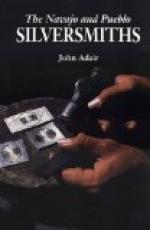For an anvil they usually use any suitable piece of iron they may happen to pick up, as for instance an old wedge or a large bolt, such as the king-bolt of a wagon. A wedge or other large fragment of iron may be stuck in the ground to steady it. A bolt is maintained in position by being driven into a log. Hard stones are still sometimes used for anvils and perhaps they were, at one time, the only anvils they possessed.
Crucibles are made by the more careful smiths of clay, baked hard, and they are nearly the same shape as those used by our metallurgists, having three-cornered edges and rounded bottoms. They are usually about two inches in every dimension.
Fig. 1, Pl. XVIII represents one of ordinary shape and size, which I have in my collection. The Navajos are not good potters; their earthenware being limited to these crucibles and a few unornamented water-jars; and it is probably in consequence of their inexperience in the ceramic art that their crucibles are not durable. After being put in the fire two or three times they swell and become very porous, and when used for a longer time they often crack and fall to pieces. Some smiths, instead of making crucibles, melt their metal in suitable fragments of Pueblo pottery, which may be picked up around ruins in many localities throughout the Navajo country or purchased from the Pueblo Indians.
The moulds in which they cast their ingots, cut in soft sandstone with a home-made chisel, are so easily formed that the smith leaves them behind when he moves his residence. Each mould is cut approximately in the shape of the article which is to be wrought out of the ingot cast in it, and it is greased with suet before the metal is poured in. In Figs. 2 and 3, Pl. XVIII, are represented pieces of sand-stone, graven for molds, now in my possession. The figures are one-third the dimensions of the subjects. In the middle cavity or mould shown in Fig. 2, Pl. XVIII, was cast the ingot from which was wrought the arrow-shaped handle of the powder-charger shown in Pl. XIX; in the lower cavity depicted in the same figure was moulded the piece from which the bowl of this charger was formed. The circular depression, delineated in the lower right corner of Fig. 3, Pl. XVIII, gave form to the ingot from which the sides of the canteen-shaped tobacco-case (Fig. 6) was made.




